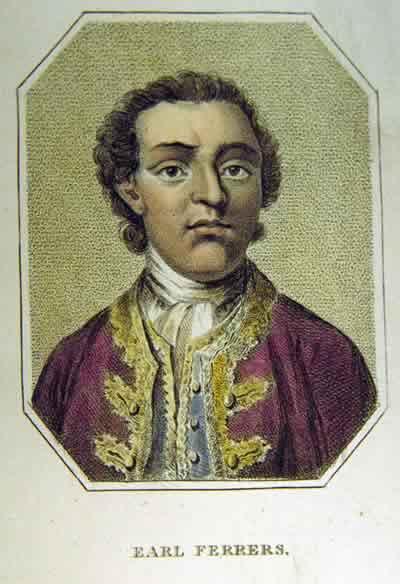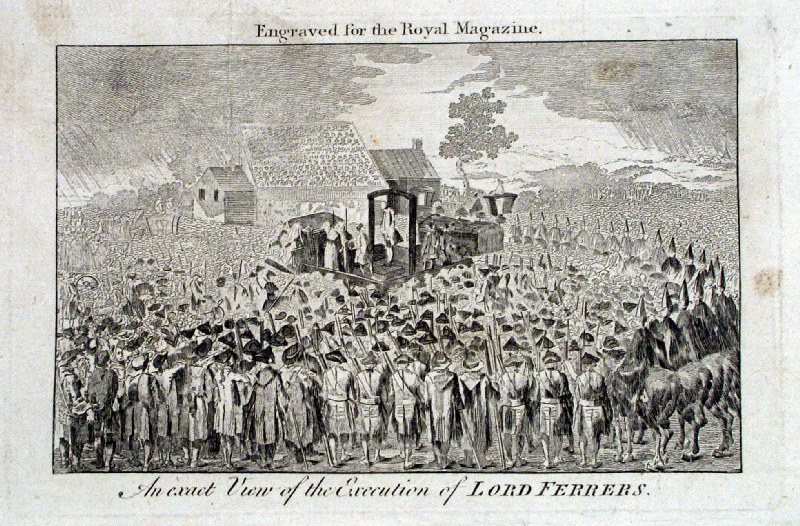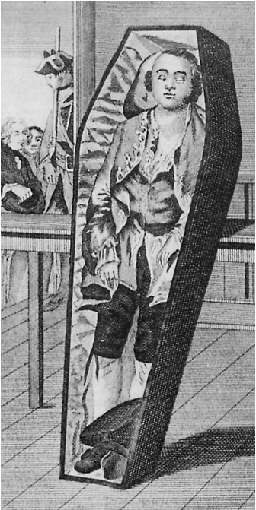Lord Ferrers and the Silk Rope September 28, 2012
Author: Beach Combing | in : Modern , trackbackBeach read the following description of an execution this summer and it has remained in his mind so vividly that he thought that he would share it here. Lord Ferrers (obit deservedly 1760) was a bad lot who used to put fireworks in his wife’s bed (he loathed her) and eventually shot a steward who got on his nerves. For that last prank he became the only English lord to be executed in the eighteenth century.
Lord Ferrers was tried by his peers in Westminster Hall, and found guilty; he was condemned to be hanged, and to the mortification of the peerage, to be anatomised, according to the tenor of the new Act of Parliament for murder…. On the last morning, May 5, the Earl dressed himself in his wedding-clothes, saying he thought this at least as good an occasion for putting them on as that for which they were first made. He wore them to Tyburn: this marked the strong impression on his mind. His courage rose on the occasion: even an awful procession of above two hours, with that mixture of pageantry, shame, and ignominy, nay, and of delay, could not dismount his resolution.
Two hours through central London… Gridlock and impending death.
He set out from the Tower at nine, amidst crowds of thousands. First went a string of constables; then one of the sheriffs in his chariot and six, the horses dressed with ribbons; next, Lord Ferrers, in his own landau and six, his coachman crying all the way; guards at each side; the other sheriff’s carriage following empty, with a mourning coach and six, a hearse, and the Horse Guards. Observe, that the empty chariot was that of the other sheriff, who was in the landau with the prisoner, and who was Vaillant, the French bookseller, in the Strand. Lord Ferrers at first talked on indifferent matters, and observing the prodigious confluence of people (the blind was drawn up on his side), he said ‘But they never saw a lord hanged, and perhaps will never see another.’ One of the dragoons was thrown by his horse’s leg entangling in the hind-wheel: Lord Ferrers expressed much concern, and said, ‘I hope there will be no death to-day but mine,’ and was pleased when Vaillant told him the man was not hurt… The chaplain of the Tower, who sat backwards, then thought it his turn to speak, and began to talk on religion; but Lord Ferrers received it impatiently. Meanwhile, the procession was stopped by the crowd. The Earl said he was thirsty, and wished for some wine and water. The Sheriff refused him. ‘Then,’ said the Earl, ‘I must be content with this,’ and took some pigtail tobacco out of his pocket.
Then came the time for tipping the ‘servants’.
As they drew nigh, he said, ‘I perceive we are almost arrived; it is time to do what little more I have to do’; and then taking out his watch, gave it to Vaillant, desiring him to accept it as a mark of gratitude for his kind behaviour, adding, ‘It is scarce worth your acceptance; but I have nothing else; it is a stop watch, and a pretty accurate one.’ He gave five guineas to the chaplain, and took out as much for the executioner. Then giving Vaillant a pocket-book, he begged him to deliver it to Mrs Clifford, his mistress, with what it contained. When they came to Tyburn, the coach was detained some minutes by the conflux of the people; but as soon as the door was opened, Lord Ferrers stepped out, and mounted the scaffold: it was hung with black by the undertaker, and at the expense of his family.
‘Nothing in his life became him like the leaving it…’ Certainly there were no fireworks beneath the bed here.
Under the gallows was a new invented stage, to be struck from beneath him. He showed no kind of fear or discomposure, only just looking at the gallows with a slight motion of dissatisfaction. He spoke little, kneeled for a moment to the prayer, said ‘Lord, have mercy upon me, and forgive me my errors’, and immediately mounted the upper stage. He had come pinioned with a black sash, and was unwilling to have his hands tied, or his face covered, but was persuaded to both. When the rope was put upon his neck, he turned pale, but recovered his countenance instantly, and was but seven minutes from leaving the coach to the signal given for striking the stage. As the machine was new, they were not ready at it; his toes touched it, and he suffered a little, having had time, by their bungling, to raise his cap; but the executioner pulled it down again, and they pulled his legs, so that he was soon out of pain, and quite dead in four minutes.
The times are interesting. Seven minutes from leaving the coach to death. Most modern executions reckon on less than two minutes – often far less – between leaving the condemned cell and oblivion. As to four minutes on the gallows… Well, Beach hopes poor old Ferrers wasn’t conscious for most of that time.
He desired not to be stripped and exposed; and Vaillant promised him, though his clothes must be taken off, that his shirt should not. The decency ended with him: the sheriffs fell to eating and drinking on the scaffold, and helped up one of their friends to drink with them, as the body was still hanging, which it did for above an hour, and then was conveyed back with the said pomp to Surgeons’ Hall, to be dissected: there is a print of ‘Lord Ferrers, as he lay in his coffin at Surgeons’ Hall.’ The executioners fought for the rope, and the one who lost it cried. The mob tore off the black cloth as relics; ‘but’, says Walpole, ‘the universal crowd behaved with great decency and admiration, as well they might; for sure no exit was ever made with more sensible resolution, and with less ostentation.’
Earl Ferrers had petitioned George II that he might die by the axe but the (foreign) king had refused outright: ‘He has done,’ said the old king, ‘de deed of de bad man, and he shall die de death of de bad man.’ Ferrers did though gain one small aristocratic privilege: he was hung on a silk rope! Beach has been thinking about this and can’t see that it would make any difference to Ferrer’s experience of death: drbeachcombing AT yahoo DOT com It was presumably at one with the black crepe on the gallows, perhaps it was even a matching colour?





